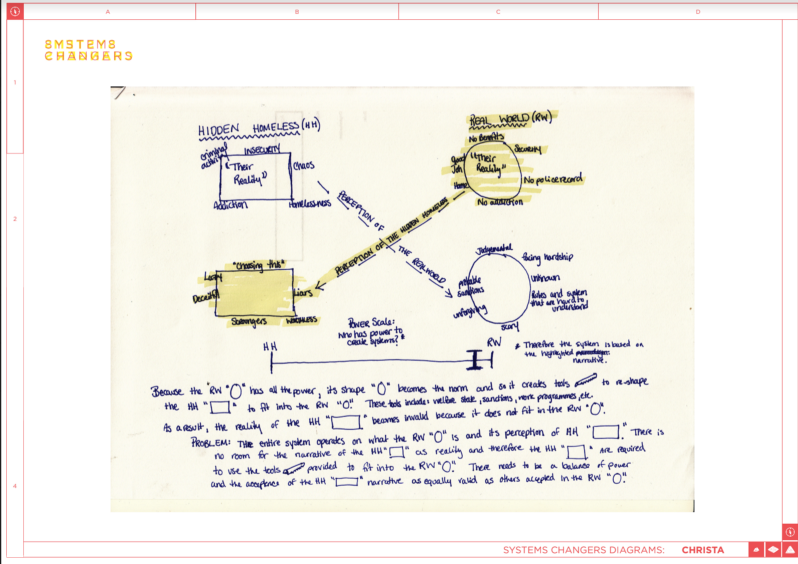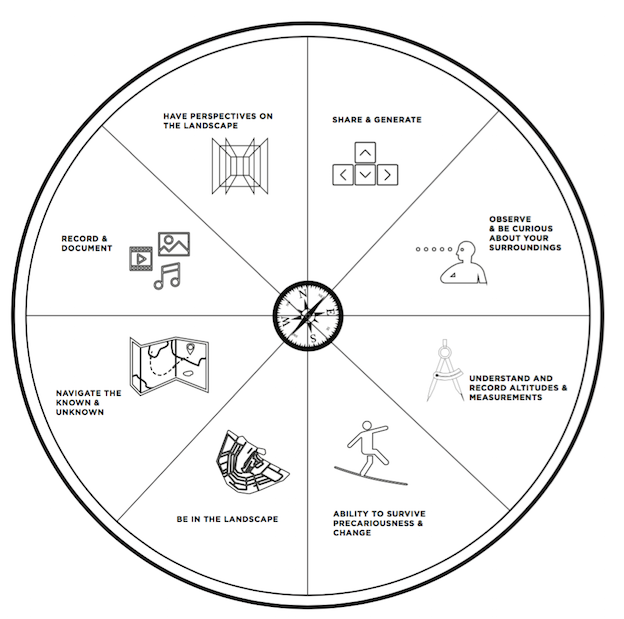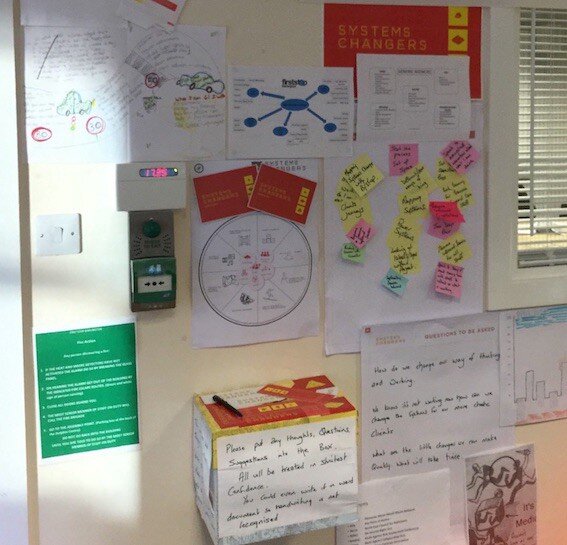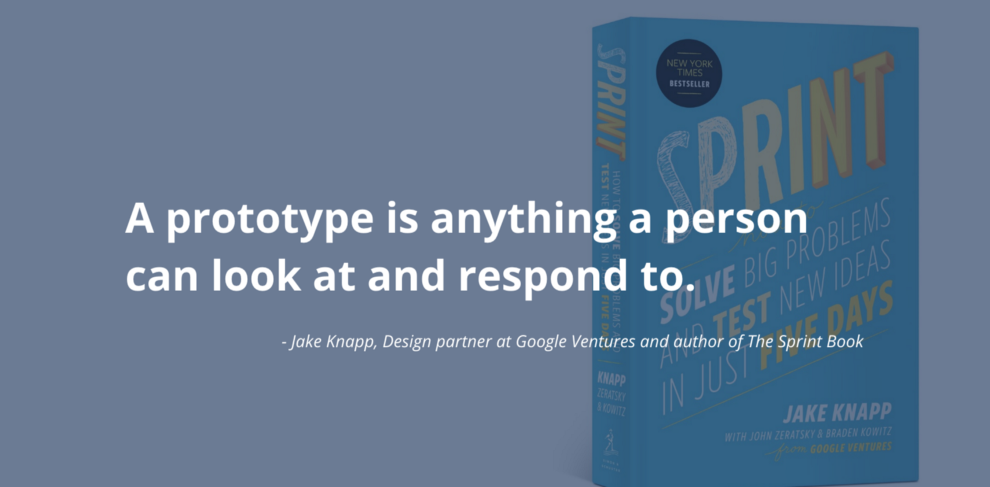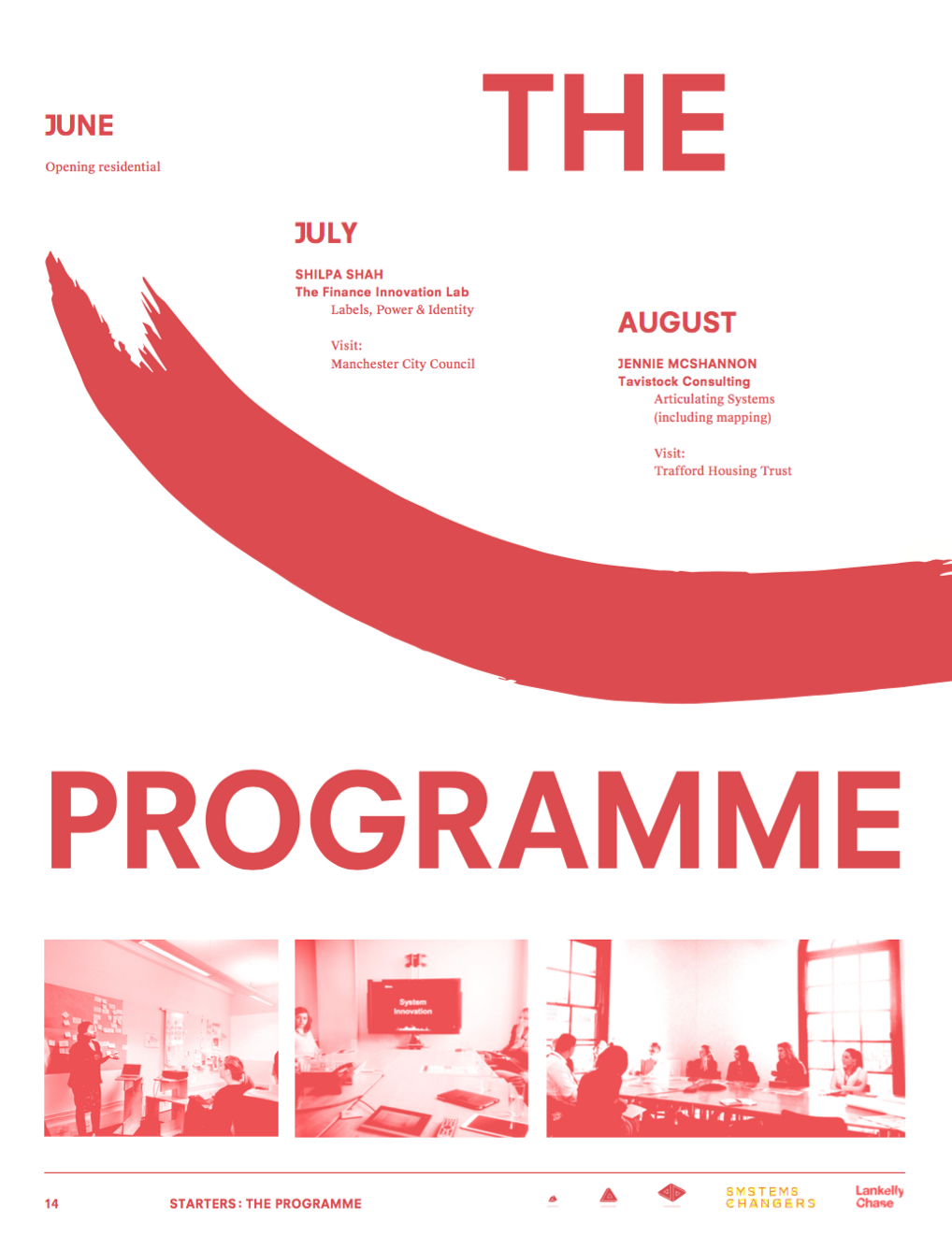A simple (but long) run-through of the Systems Changers programme
We are 5 months in to the Systems Changers programme with the Children’s Society and Lankelly Chase and there will be more posts to come about the learning from that, but as the programme evolves and is adapted for different contexts I thought it might be valuable to write a post that simply lays out the programme in it’s simplest form* — as it was, when we first designed it, back in 2014 (delivered in 2015).
The programme was initially designed for frontline workers working in organisations trying to change the systems that perpetuate severe and multiple disadvantage. It was designed to be a 6 month programme, with 10–12 participants. The ambition was that it could always be used in other contexts — with all the different people working in those systems — from commissioners and policy makers through to middle managers and local citizens.
The premise of the programme was to take & deploy a systemic lens for change by…
Acknowledging the Sectors that have less power & voice
Making the invisible, visible
Building systems’ adaptive capacity
And in 2018 we edited and adapted the design principles.
The programme has always used the three lens’ as shown below — to build a literacy in plural perspectives and holding both the micro and macro view.
The programme has always emphasised the middle space visualised below. It has some aspects of a personal development programme, but that is not what it is. In the same way it isn’t an incubator or accelerator programme fixated on solutions. In fact we always said that if people left their jobs after taking part in the programme, we had failed. The programme is about surfacing, nourishing and directing the wisdom (insights) from the frontline to influence change. It was always a challenge to hold this space — people on the frontline like springing in to action and are great “do-er’s” and problem solvers.
And the focus was always on the collective insights (intelligence and wisdom) of the group as much as on each frontline workers individual journey and experience. What does the collective know that the individual can’t? How can a collective sense-making across a system be useful in generating new insights? It’s why the programme was originally designed to be made up of people working in different places and parts of the system.
The programme broadly follows the stages below, although it is not linear — the mapping, testing, reflecting and adapting are all continuous.
The participants were asked to do maps of the systems in which they work, or/and the systems that they wanted to change, for the interview. We also ensure that everyone applied with their manager so that they had permission to make space for the programme and feel able to surface insights about their organisations to reflect back to them.
The Residential
The programme starts with the Residential. Even in this latest iteration of the programme, I don’t think we’ve figured out how to run the programme in a way that doesn’t need this kind of introduction. It’s very resource intensive and not very scaleable.
Alongside time to get to know one another, meet the delivery team, and understand the functions of things like the Learning Lab, learning partners and coaching, the residential is primarily an introduction to systems thinking and design.
Cartography
We start with an analogy of cartography (inspired by some materials Sian had been developing for her students) — using the visual below to mark the start of the Systems Changers journey.
Using this framing we talk through and explore each one. What does it mean to do the following, in the context of the programme?
Have perspectives on the landscape — which provides a way to introduce the 3 lens’s of the programme (individual, organisation, wider system)
Record and document — what are the ways to record and document the programme and why it’s important to do so. Who of your fellow travellers is visual? Who is a talker? Who writes? How are you going to record what you find? We talk about gathering data, and how documenting gives you material to be a better reflexive practitioner.
Navigate the known and unknown — the programme is likely to place people in surroundings, language, learning etc that is unfamiliar to them. We ask them to think about when they did something different to the usual — when they went off the beaten track.
Be in the landscape — sometimes it’s important to really *be* in the landscape. To observe, to be present, to sense, to experience it from another’s perspective. We talk about the value of ethnography and the importance of not making assumptions. Experience it for yourself!
Ability to survive precariousness and change — be a camel! Plan for the long haul because change takes time. It requires patience, vulnerability and it is never predictable.
Record altitudes and measurements — this is all about gathering evidence and using different types of data. Feelings are data, digital can be data.
Observe and be curious about your surroundings — we encourage people to use all their senses. To explore what the terrain is like. To literally go outside. Open doors.
Share and generate — like Hansel & Gretel we encourage people to leave a trail — to practice and design for sharing, being open and transparent to help others navigate. Being generative also helps new patterns emerge and things come in to view differently.
Design, Design thinking and systems thinking
The rest of the residential is like one mammoth lesson in Design and in Systems Thinking and Systems Design — the slides for that are here, and it’s too long to blog about!
Connecting with the planet and our ecological systems
Traditionally the residential’s have taken place in the countryside where we could draw on fellow Point Person Hannah’s experience of building intimacy with nature and weaving analogies between ecological and planetary systems, together with our human systems. We haven’t figured out good ways to do this in an urban environment and with less resource, which is a real shame as it was quite pivotal in the first few programmes for helping participants connect with the heady concepts of systems thinking etc. Some of Hannah’s brilliant exercises and activities — which draw on her extensive experience in group process, coaching and nature-based work — are here.
Socialising the programme
Another touch point that I think is really important is how participants ‘socialise’ the programme back in their organisations. We give everyone a “kit” to take away and use to decorate a space back in the office — posters, information and tools (that invite participation) showing what the programme is about — taking their wider organisation on a journey of change too.
Month 1
Understanding the system — Day 1
The purpose of this day is to deepen participants’ understanding of:
‘People in systems’ including themselves and how to explore this
How power and judgements play out in relation to the self, organisation and system.
In this session participants are led through processes to help them understand their role in systems. Taking the 3 lens approach to change (self, organisation, system), they start first with the self, asking questions like:
What shapes our sense of identity? What are the labels that we apply to ourselves and others?
How do these labels shape our perceptions, experiences, values and opportunities?
How is our personal power affected by the labels others apply to us and we apply to others?
In the first two programmes Shilpa Shah ran whole day sessions looking at structural, cultural and personal labels — asking questions such as:
Which aspects are visible/invisible?
Which aspects are dominant/subordinate/neutral?
Which labels did I choose? Which labels were not a choice?
Have I changed or modified any of these aspects to fit in?
What’s good about being a ….
What’s difficult about being a ….
How do these labels affect our perception of ourselves and others?
How do these labels affect others’ perceptions of us?
How do these labels empower or limit us in our work to create change?
Understanding the system — Day 2
The purpose of the day is to help participants use their voice and feel more confident to do so — following on from the day before where they located their identity and beliefs in change. Working with Jude Habib from Sound Delivery, the focus of the session is on:
Experimenting with their voice
Trying different voices on
Testing out tools for having their voice heard
The intention is that participants leave the session feeling able to:
Express their voice through different tools (on camera, through audio etc)
More confident to express themselves
Clearer about what they want to express
Comfortable to try and experiment with different voices
An introduction to “Dark matter”
The last part of the second day is an introduction to the concept of “dark matter” — deepening their understanding of systems by looking at the norms, culture, rules, process and structures in systems. A key part of ‘Seeing the System’ is understanding these rules and processes — they can be invisible but are very powerful. They often shape the way frontline workers, their organisations and those that commission them are able to work. Seeing dark matter is about seeing what can be shifted and where to find the flex to make positive change in the system.
‘The city we experience is, to some extent, a product of a city
council’s culture and behaviour, legislation and operational modes,
its previous history and future strategy, and so on. The ability for a
community to make their own decisions is supported or inhibited by
this wider framework of ‘dark matter’, based on the municipality
they happen to be situated within as well as the characteristics of
the local culture.’ Dan Hill on Dark Matter in Systems
We encourage the frontline workers to question which rules and processes might seem to be fixed and immovable, but which actually can be changed. We look at the different types of ‘dark matter’ at play in the system around complex disadvantage — law and guidance, strategies and policies, contracts and processes. We examine how what can seem to be the law may actually be someone’s interpretation of it. We look at how through investigation you can start to question rules, by discovering that the reason the rule was initially created may have changed, so that the rule is no longer needed.
In between the first and second months, participants are asked to go in search of the ‘dark matter’ in their organisations. Like archivists and ethnographers they gather evidence to bring with them to Month 2. This includes the tools above as well as things like journey mapping and a data audit.
Month 2
Finding the flex — Day 1
The purpose of Day 1 is to draw on the data that the participants gathered in their Dark Matter explorations — mapping and unearthing exercises — and use it:
To develop an understanding of systems dynamics and how to find the flex.
To learn the skills needed to do cause & effect mapping and feedback loops.
To explore barriers to change — both organisationally and personally.
Some of the tools used in this session are found here. Broadly they take people through the following:
Multiple Cause Diagrams
How to surface different perspectives (above and below the surface)
How to discard detail
How to see the cause and effect — it’s not linear!
How to use Multiple Cause Diagrams and why they are useful — (used to trace the sequence of cause and effect through a situation/system) — and can be useful for clarifying one’s own thinking, identifying potential interventions, debate what is going on, and identify feedback loops.
Participants do their own Multiple Cause Diagrams using an issue or problem that has resisted attempts to change, that they identified in their “homework.”
This involves, identifying the event or variable at the centre of this issue, extending the diagram backwards by asking “what causes this?” and forwards by asking “what does this lead to?”, check for connections between items on the diagram (if necessary iterate by starting again), identifying any feedback loops and reflecting on understanding of the issue.
Feedback Loops
Participants also get a deep dive lesson feedback loops. Feedback loops are sequence of causes that feeds back on itself. When the effect is additive it is described as positive feedback (reinforcing) and when the effect is to subtract or counteract the initial cause then the feedback is known as negative feedback (cancelling).
All situations that involve growth and change include a positive feedback loop. All situations where a system is being controlled include a negative feedback loop.
Most real world situations involve several loops — of both types. Positive circles — also known as vicious and virtuous circles — and an important reason why unintended consequences and side effects to interventions are so prevalent — the extent to which actors in a system ignore the interconnections between the parts and ignore the effects of feedback.
Through understanding the cause and effect in the system. And the reinforcing and stabilising feedback loops, participants are able to see where it is that they want to start experimenting with change.
Finding the flex — Day 2
Now that the Systems Changers have more systems literacy and have ways to identify flex in the system, how can they test and use that flex? What kinds of change might they be able to create? In Day 2 we cover three things:
Understand how to create theories of change
Understand different levers of change
Understand how to do systems prototyping — designing a range of experiments and potential interventions.
Plurality is an important part of the day, as it’s likely that there will be multiple ways that each person can create or influence change. By the end of these sessions the aim is for the Systems Changers to recognise that change happens in different ways, in different parts of the system.
The day starts with an introduction to Theories of Change — with the cohort articulating their own theories of how they think change can start to happen, and the kinds of outcomes they want/ expect to see from the changes. Following on from the exercise of articulating hunches about how and where change can happen, the method of prototyping is introduced. Not as a way of finding solutions to the changes the cohort describe, but as a way of asking questions about the change and experimenting with the questions.
The second part of the day is about bringing together theories of where flex in the system opens a window for influencing change, alongside a range of different prototyping methods to test and experiment with those windows (or levers) for change. We describe this as “Systems Prototyping” — experimenting with a range of opportunities for change, but with a coherent (and plural) narrative that links them all together — some are simultaneous experiments and some in sequence.
The work they go away to do this month is more gathering of evidence about where they see flex in the system and the potential for change. They go off and do ethnography, interviews, mapping and plotting to make the case for their experiments and to find coherence across the different ways they intend to prototype change.
Month 3
Making change happen — Day 1
Month 3 is all about the different ways to make change happen. The cohort have identified multiple areas of flex, started to plot out, as systems prototypes, some of the micro-experiments they want to do and are now introduced to a range of “change makers” who have experience using different approaches to influencing and experimenting with change.
In the first few programmes we either had speakers come in and give short talks about their experience of doing this kind of change work, or we took the cohort on visits. That has included visits to the GLA, Policy Lab,Government Digital Service, FutureGov, OnRoad Media, NEON and the People’s History Museum.
Making change happen — Day 2
Day 2 is all about “systems readiness” and understanding how to build networks and alliances to influence change.
Change always requires relationships and allies.
It also always requires the quiet and slow work of preparing and cultivating the ground for change — people, organisations and the wider system — so that it (the system), and they, anticipate the change, and plan and budget for it.
Some of the relational mapping and tactics tools we use — the kinds of questions the participants will be asking themselves are: who else do I need on board? Why should they care? What will they need to see and understand? What can I show them? What is the ask?
The cohort leaves these two days ready to go and start their experimenting.
Month 4
Experimenting with change — Day 1
This whole-day session is designed as Studio Time — a space for the cohort to reflect on what’s happened with their experiments so far, to develop them and also design new ones. They come to the session with scenarios like…
I’ve done some experiments. I’d like to reflect on what I’ve learnt and think about how they make sense in the wider context of the many experiments I want to do.
I’d like to design some new experiments.
I’ve done some experiments and want to keep experimenting with the same question in deeper/ different ways.
I’ve done something and don’t know what to do next…
I didn’t manage to do any experiments…
The Studio Time has bookable support surgeries too — the support on offer includes the following:
Prototyping
User research
Story and narrative
Engagement
Sense-making
Partnerships
Influencing (internally and externally)
Data and digital
Experimenting with change — Day 2
The Purpose of the day 2 is for the cohort to feel supported and ready for the next stage of their experimenting and to better understand their inner journey of change.
The first session helps the cohort understand the inner journey of change-making, including self authorisation, boundaries and resistance (inner and outer). It’s really difficult to change the system. Feedback loops (and entrenched/old power) can be very powerful and with this resistance in the system it’s hard to break the cycle.
If you can understand what’s difficult about changing something on a personal level then you can get a better sense of why the system also resists change. So we use a tool called Immunity To Change and do an exercise in Force Field Analysis to look at our personal systems and think about what it is that makes us so resistant to change.
The cohort leave these sessions to go and continue with their experiments, plotting them on their Systems Prototyping map. They also have a deeper understanding of why change can feel so hard.
Month 5
Experimenting with change — Day 1
The purpose of this day is for the cohort to learn more about how to build narratives, coherence and influencing strategies around their change experiments. A range of speakers talk through:
Working with the media
Building systemic narratives
Using framing
Strategic communications
Storytelling
Policy influencing
Presenting and “show & tells”
The experts then run a Story Studio, working with the cohort to design their own narratives, stories and talks.
Experimenting with change — Day 2
The whole day is used as Studio Time. And briefing the cohort to collect their experiments, insights and learning together for the final residential.
Learning and Reflection
Alongside the programme as it’s been laid out here, there were also the following elements:
Free-writing power reflections that happen at the end of each session. Principles of free-writing power reflection:
Give the question/ theme
Let the participants know that they will not be reading this back to anyone and that it does not need to make sense
Write the first thing that comes into their mind, don’t edit or judge
Keep the pen moving- if they get stuck, different techniques include repeating the question in writing, or drawing a spiral until you think of another word.
Once the time is up give them a few minutes to read over what they’ve written and underline any words or phrases that feel important.
A coach — available to support the cohort in their own personal journey’s through the programme. Change work can be hard!
A Learning Partner — in the first few programmes this was a crucial role and distinct from the Coach. The Coach’s role was to support people, the Learning Partner was there to surface insights with each Systems Changer — what were they observing and what insights were they generating at an individual organisational and systems level? This was done as a monthly call and interim visits to see the Systems Changer in their work place.
A Learning Lab — in the first year we had a physical space and a learning framework, as written about here. The focus was on the collective intelligence of the cohort, and how those insights, surfaced through their own experiences in different contexts and organisations, could be used to influence change. Key to the Learning Lab is ongoing documentation and content creation — generated by the cohort and the delivery team, to create regular feedback loops so as to “reflect the system back to itself.”
Some of the tools and content from the original programme can be found here on the Lankelly Chase website.
Last week the Point People published a new tool — the Systems Canvas — which encompasses a lot of our collective learning from doing systems change work and designing the Systems Changers programme.
*We do ultimately still plan to host all of this on a website that is easy to access and download tools and guides from!
I’d like to acknowledge all the people (alongside the Point People) who have contributed content to this programme — Sarah Drummond and Shilpa Shah. As well as all the Lankelly Chase team who have supported this programme and in particular Alice Evans, who’s idea it was in the first place.






